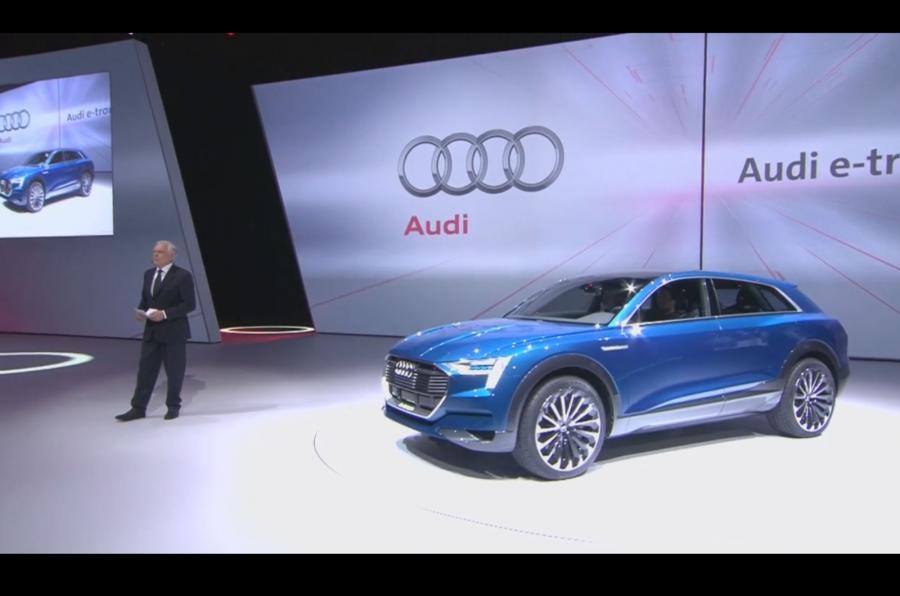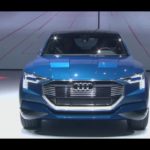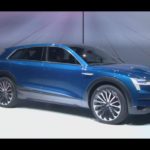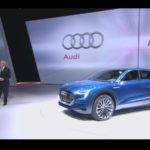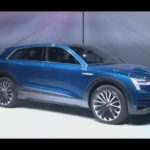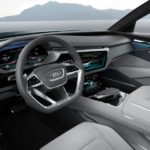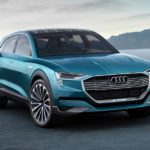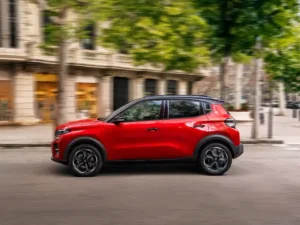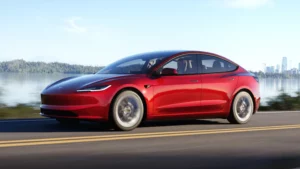The Frankfurt Motor Show kicks off and shows a number of interesting Electric Car from Audi and Porsche.
As Tesla sales continue to grow with the Model S and the soon to be released Model X the German marques are getting concerned and starting to show their cards on how they plan to fight back.
Audi E-Tron
First up the Audi E-Tron concept will hit the streets as the Q6 e-tron in 2018, according to Autocar. We will showcase the Porsche concept car in a later post.
 The Audi EV was Audi Concept at last years show in concept form. Audi has already confirmed that it will be offered for sale, badged as the Q6 e-tron quattro. Dr Ulrich Hackenberg, Audi’s head of research and development, said, “It’s a concept car but it’s very close to the production car.”
The Audi EV was Audi Concept at last years show in concept form. Audi has already confirmed that it will be offered for sale, badged as the Q6 e-tron quattro. Dr Ulrich Hackenberg, Audi’s head of research and development, said, “It’s a concept car but it’s very close to the production car.”
Luca de Meo, Audi’s sales and marketing boss, told Autocar that the electric model will “cost about the same as a well-specced Audi A6”. That suggests it will appear at a price point of at least £60k
The e-tron-quattro sports a bold new design that suggests future electric models from Audi will have their own aerodynamically optimised look. It draws on the latest developments in lightweight construction, aerodynamics, battery technology and electric drive systems to provide the performance to challenge the fastest of Audi’s existing petrol, diesel and electric SUV models whilst delivering a claimed zero-emission range of up to 311 miles.
“Audi will present an electric SUV in early 2018. The e-tron quattro concept provides a concrete foretaste of this,” confirmed Hackenberg, before later revealing, “We will use this car to introduce this technology to a bigger number of customers in the market. We’ll fill one factory [with production].” When asked of the scale of the plant he said, “I won’t tell you about the size of the factory but it’s a lot. It’s not a small one.”
This vehicle will in some ways be pitched at the Tesla Model X as they will be similar sized, with similar range and similar price. With the existing Audi A3 E-tron plug-in Audi, have some first hand experience in the EV world. However this will be at least two years behind the Tesla SUV and a lot can happen in those years. Also Tesla is building out a pan Europen charging network of fast charging points for Model S and X owners, permitting them to drive virtually all over Europe for free and with minimal charge time. Audi are pushing a 150KW rapid charge technology in the Q6. No mention of what this is or where you would find a 150 KW power point. They have also highlighted a more reasonable 11Kw wireless charging system using Inductive technology. Apparently the car will include a piloted parking function that has been conceived to automatically park over a charging plate imbedded in the ground. The charging process starts automatically, with a magnetic field providing an alternating AC current that is converted to DC by the e-tron quattro’s electronic package. Once the battery is topped up, the charging automatically ceases. The whole process can be monitored and controlled via a smartphone app. We wait to see if this is the end of cables as we know them and more details on where a charge plate could be installed. In a home garage would seem ideal but would look to be a complex and messy retrofit to a floor.
Specs include Three motors and up to 496bhp with 95 KWh battery pack
At the heart of Audi’s concept Q6 is an in-house developed electric drive system. It uses three motors – one mounted up front sending drive to the front wheels and the remaining two sited at the rear acting on the rear wheels. Nominal power is put at 429bhp, although a boosting function made available in the more sportier of two drive modes temporarily increases its maximum output to 496bhp. It is accompanied by peak torque of 590lb ft.
The power is sent to all four wheels via a drive-management system. An electronic torque-vectoring function also apportions power between the individual rear wheels depending on grip levels. The gearbox offers the choice between two modes: Drive and Sport.
Audi is yet to reveal a weight figure for the e-tron quattro. However, it is claimed to have an 0-62mph time of just 4.6sec. Top speed is limited to 131mph to preserve the battery charge. All of that power is good enough to push the sleek concept to 100 kilometers per hour (62.1 miles per hour) in 4.6 seconds. Top speed will be electronically limited to 130.5 mph. This isn’t Tesla ludicrous territory, but is should feel plenty peppy on the road.
Energy to run the electric motors is drawn from a large liquid cooled 95kWh battery bolted to the floor below the passenger compartment – a position aimed at providing the new SUV the lowest possible centre of gravity while achieving a front-to-rear weight distriubution of 52:48. Hinting at its modular nature, Audi says the lithium-ion unit is suitable for other future electric models.
On a full charge, the battery is claimed to provide the e-tron quattro concept with a range of over 311 miles based on the criteria used in the New European Driving Cycle (NEDC) test procedure.
As for charging, the concept offers a few ways to fill up the 95-kWh battery pack. There’s the expected SAE Combo/Combined Charging System (CCS) outlet as well as wireless induction charging. Audi says that a 150-kW DC fast charger can fill up the pack in around 50 minutes, but good luck finding a plug that can handle that much power – even in 2018.
Active aerodynamics
Stretching to 4880mm in length, 1930mm in width and 1540mm in height, the e-tron quattro is 250mm longer, 30mm wider and 115mm lower than the existing first-generation Q5. Yet despite the generous dimensions, the drag co-efficient is significantly better than any of Audi’s current SUV models at 0.25.
In a preview of the aerodynamic measures being pursued for the production version of the new Audi model, active body elements deploy above 50mph to provide more efficient airflow and added cooling potential at the front; the side sills extend in length by 50mm to smooth the flow of air past the rear wheels; a spoiler atop the tailgate extends by 100mm to elongate the roof line; the diffuser extends to speed the airflow rate at the rear and flat paneling sporting a special finish resembling the surface of shark skin is used underneath.
The interior of the e-tron quattro draws heavily on the design originally unveiled on the Prologue concept at last year’s Los Angeles motor show. It provides seating for up to four, with two individual seats front and rear. Boot space is put at 615 litres – 75 litres more than that offered by the first-generation Q5. Owing to the lack of a traditional exhaust system, the luggage compartment area is set low. With the rear seats folded, capacity increases to 1725 litres – some 350 litres less than that of the new Q7.
Hackenberg explained the driving force behind the creation of the Audi e-tron quattro: “This is the SUV that sales and marketing were asking for. We [the engineering division] wanted a car with low rolling resistance. This concept combines both, together with Audi’s core values: quattro four-wheel drive, air springs, aerodynamics.”
The ultra-efficient aerodynamics of the e-tron quattro are the result of an internal Audi design competition, explains Ingolstadt’s exterior designer Andreas Mindt: “We had an internal competition to develop the aerodynamics, with four teams developing quarter scale prototypes in the wind tunnel”.
The rings of OLED lights at the corners of the e-tron quattro will become shorthand to signify a plug-in vehicle in Audi’s range.
Audi Press Release:
Audi e-tron quattro concept: Electric driving pleasure with no compromises
A foretaste of the production version: The electric-powered Audi e-tron quattro concept. Range of more than 500 kilometers (310.7 mi) for full everyday usability. New concept combines aerodynamics and creative design solutions
Flow-enhanced design with a drag coefficient of 0.25; a powerful, all-electric e-tron quattro drive with up to 370 kW – Audi is presenting the Audi e-tron quattro concept at the International Motor Show (IAA) 2015 in Frankfurt. The car is the company’s statement about the future of electric mobility: It is sporty, efficient and suitable for everyday use.
“Audi will present an all-electric, luxury-class sport SUV in early 2018. The Audi e‑tron quattro concept provides a concrete foretaste of this,” says Prof. Dr. Ulrich Hackenberg, Member of the Audi Board of Management for Technical Development. “It combines driving pleasure with great range, an expressive design and excellent comfort.”
Electric power
The Audi e‑tron quattro concept uses the power of three electric motors: One electric motor drives the front axle, the two others act on the rear axle. Total output is 320 kW. The driver can even mobilize 370 kW and over 800 Nm (590.0 lb-ft) of torque temporarily while boosting. The concept study thus performs like a sports car. When the driver floors the right pedal, the Audi e‑tron quattro concept sprints from a standstill to 100 km/h (62.1 mph) in 4.6 seconds and quickly reaches the electronically governed top speed of 210 km/h (130.5 mph).
The concept with three electric motors which Audi is presenting for the first time makes the technology study an e‑tron quattro. An intelligent drive management system controls the interplay between them as appropriate for the situation. The focus here is on the greatest possible efficiency. The driver decides on the degree of recuperation, the driving program S or D and the mode of the Audi drive select system.
During sporty driving on a winding road, the Torque Control Manager actively distributes the power between the rear wheels as necessary. This torque vectoring provides for maximum dynamics and stability.
The large lithium-ion battery is integrated into the floor of the passenger compartment. It gives the Audi e‑tron quattro concept a balanced axle load distribution and a low center of gravity – prerequisites for its dynamic handling. The battery’s capacity of 95 kWh enables a range of more than 500 kilometers (310.7 mi). The Combined Charging System (CCS) enables charging with DC or AC electrical current. A full charge with DC electrical current at a charging column with an output of 150 kW takes just around 50 minutes. As an alternative, the study is equipped with Audi Wireless Charging technology for contactless induction charging. The charging process is very convenient. The Audi e‑tron quattro concept uses a system for piloted parking that guides it to the proper position at the charging plate. In addition, a large solar roof provides electricity for the drive system battery on sunny days.
The chassis also expresses the high-tech character of the concept study. The adaptive air suspension sport, which features controlled damping, lowers the body at higher speeds to reduce drag. The dynamic-all-wheel steering combines a dynamic steering system on the front axle with a steering system for the rear wheels. Depending on speed and the driving situation, they steer either opposite or in the same direction as the front wheels. The Audi e‑tron quattro concept thus reacts even more spontaneously and stably, and is also very manoeuvrable at low speeds.
Aerodynamic: The exterior design
The Audi e‑tron quattro concept harmoniously combines the design with the aerodynamics and all-electric drive system. The five-door technology study is 4.88 meters (16.0 ft) long, 1.93 meters (6.3 ft) wide and just 1.54 meters (5.1 ft) high. Its coupe-like silhouette with the extremely flat greenhouse that tapers strongly toward the rear lends it a very dynamic appearance. The car’s drag coefficient measures just 0.25 – a new best for the SUV segment, where figures are usually considerably over 0.30.
All of this contributes considerably to the long range of more than 500 kilometers (310.7 miles). At speeds from 80 km/h (49.7 mi), electrically actuated aerodynamic elements on the engine hood, the flanks and at the rear end direct the flow of air as needed to improve the flow through and around the vehicle. This is one example of the intensive development work in the wind tunnel. Wind noise is low on board the car, and there are no engine noises in an electric car in any case. The fascination of electric driving unfolds in near total silence.
The vertical separating edges on the side panels and the fully enclosed floor pan with its newly designed microstructures contribute to reducing drag. Cameras replace the exterior mirrors – another contribution to the excellent aerodynamics and also a foretaste of the future of driving.
All the main lighting functions at the front of the car use Matrix laser technology. The bottom section houses a new, distinctive lighting signature comprising five lighting elements. Each of these combines an LED luminary with an extremely flat OLED element (organic light-emitting diode). Audi is developing Matrix OLED technology for use in production vehicles and is showing it for the first time in the concept study at the IAA.
The rear lights also comprise two sections. Each of the top zones features nine red OLED units for the tail light function, with three more below.
Deep integration: The interior
The package of the Audi e‑tron quattro concept enables a spacious, comfortable interior for four persons and 615 liters (21.7 cu ft) of luggage. The interior has a light and open feel to it; its architecture melds harmoniously with the operating and display concept. All displays in the interior use OLED technology. The extremely thin films can be cut to any desired shape.
The new Audi virtual cockpit curved OLED is a further development of the Audi virtual cockpit that debuted in production vehicles in 2014. To the left and right below the fully-digital instrument cluster are two touch displays with black glass and a subtle aluminum frame. The driver controls the lights and the systems for piloted driving with the left display. The large display on the right is for media and navigation management. The steering wheel serves as an alternate control level. Its spokes are equipped with contoured touch surfaces.
Below the selector lever on the center tunnel console are two more OLED displays for the drive system status, climate control and freely programmable information functions. The curved displays in the front section of the doors serve as digital exterior mirrors.
The two rear passengers sit on comfortable individual seats. They can use the OLED displays on the center console to configure the climate control and infotainment for their area or to exchange data with the driver. An LTE module connects the Audi e‑tron quattro concept with the Internet. The connectivity features in the study are cutting edge.
The zFAS: Nerve center for piloted driving
The concept study is equipped with all the technologies that Audi has developed for piloted driving: radar sensors, a video camera, ultrasonic sensors and a laser scanner. The data these supply come together in the central driver assistance controller (zFAS) in the luggage compartment. It computes a complete model of the car’s surroundings in real time and makes this information available to all assistance systems and the systems for piloted driving. These technologies are also nearly ready for use in production vehicles.

